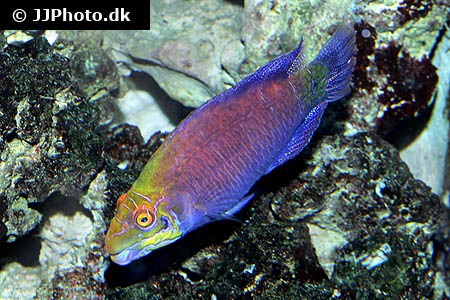Pseudocheilinus ocellatus

| Latin name | Pseudocheilinus ocellatus - Randall, 1999 |
|---|---|
| Local name | Whitebarred wrasse |
| Family | Labridae - Pseudocheilinus |
| Origin | Australia, Japan, Indonesia, East Pacific, Central/West Pacific |
| Max length | 9 cm (3.5") |
| Minimum volume |
200 l (53 gal) |
|---|---|
| Hardiness |
Average |
| Suitable for aquarium |
Suitable for most aquarium |
| Reef safe |
Always reef safe |
| Aggressiveness | Might be aggressive towards other species |
| Recommended |
Small crustaceans (Krill, mysis, artemia...) Zooplankton (Cyclops, pods...) |
|---|
This species is known to jump out of open aquaria.
This spicies might be a threat to smaller fishes.
This species poses a threat towards shrimps and crabs etc., which are relatively small.
These fish flourish better without other members of the same species in the aquarium.
This fish requires feeding several times a day, especially when newly added.
When the fish can find its natural food in the aquarium it requires less frequent feeding.
This species needs good hiding places, for example, between live rocks.
This species can be aggressive if they are not provided with adequate space.
This species can change gender from female to male.
When a male is needed, a female changes sex and takes on the role.
This species is known to feed on flatworms.
One can, of course be unlucky in having a specimen that refuses to eat them.
This species can be used to combat Pyramid snails.
One can of course be unlucky in having an individual that refuses to eat them.
This species can be very shy when first introduced into a new aquarium.
More aggressive fish can be introduced after this species has acclimatized.
Fish of the Psuedocheilinus are popular aqauarium fishes, as they are attractive and effective at keeping flatworm and pyramid snails at bay.
It is the Psuedeocheilinus hexataenia (Sixline Wrasse) one sees most in the trade. P. hexataenia can occasionally show extreme aggression towards other fish of the same size, in which case consider fish of the Halichoeres genus instead.
Eventhough these fish can be very aggressive, if they are hunted by larger, even more aggressive species, they will hide themselves.
They don´t dig themselves into the sand, but sleep between the rocks.
It is normally easy to feed them with different types of frost and flake foods. Some individuals like to eat small crustaceans, but this is usually not a problem.
Wrasses are nearly always seen in reef aquaria, since many of the species are both attractive and useful in battling a range of unwanted invertebrates like i.e. flatworms, pyramide snails.
These fish live of everything from zooplankton to large crustaceans, sea urchins and the like.
The needs and behaviour of Wrasses vary greatly, so it is vital to familiarize oneself with the specific species before buying one.
| Aquarium trade | No |
|---|---|
| Distribution | Western Central Pacific. |
| English common names |
Whitebarred pink wrasse Whitebarred wrasse |
Scott Michael. Aquarium Fish: The Whitebarred Wrasse (pseudocheilinus Ocellatus) - Advanced Aquarist - (Engelsk)
Henry C. Schultz. 2003. ...Four, Six, Eight, Who Do We Appreciate? Wrasses! Wrasses! The Genus Pseudocheilinus - Reefkeeping Magazine - (English)
Bob Fenner. Striped and Not: The Small, But Pugnacious Wrasses of the Genus Pseudocheilinus - Wet Web Media - (English)
Bob Fenner. 2011. Small, but Pugnacious: The Pseudocheilinus Wrasses - Tropical Fish Hobbyist Magazine - (English)
Scott W. Michael. 2009. Wrasses and Parrotfishes (Reef Fishes Series Book 5) - TFH Publications / Microcosm Ltd. - (English)

